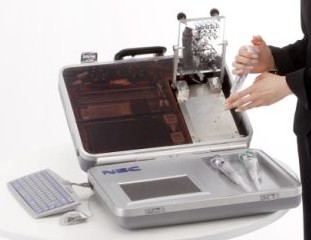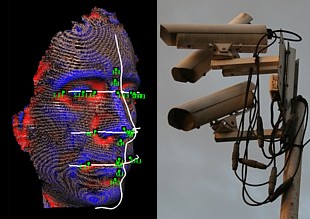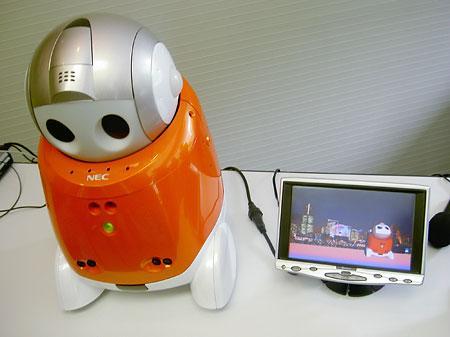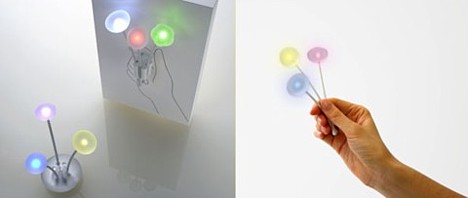
Electronics giant NEC has reportedly developed a wearable optical device that interprets foreign languages and projects a real-time translation directly onto the retina, enabling the wearer to communicate with other language speakers without an interpreter.
The prototype device — called “Tele Scouter” — consists of a tiny retinal display and microphone mounted on an eyeglass frame. The microphone picks up the conversation and transmits it to a small computer worn on the waist, which converts the speech to text and translates it into the user’s native language.
The retinal display projects the text directly into the user’s peripheral vision, allowing them to maintain eye contact with their conversation partner while reading the translation. According to the developers, the Tele Scouter can be used for hours on end without eye strain, because the wearer does not have to focus their eye on the displayed text.
Although NEC plans to put a version of the Tele Scouter on the market in 2010, the company admits the device’s translation capabilities are insufficient for real-world applications. So for now, the initial plan is to market the device as a wearable data display for employees in factories and shops.
According to the company, the device can provide instant hands-free access to data such as diagrams and operating instructions, allowing workers to perform tasks more efficiently and accurately. Other possible future applications include car navigation systems and video games.
[Source: Yomiuri]





 NEC Corporation has teamed up with Aida Engineering to develop a briefcase-sized DNA analysis system that allows police to perform comprehensive DNA testing at crime scenes in as little as 25 minutes. NEC is calling the device the world's first portable all-in-one DNA analysis system able to handle all DNA testing processes from extraction to analysis. Designed specifically for law enforcement officials and planned for release in 2008, the system measures 50 x 40 x 20 cm (20 x 16 x 8 in.), making it small enough to be carried to crime scenes or other locations where quick DNA analysis is required.
NEC Corporation has teamed up with Aida Engineering to develop a briefcase-sized DNA analysis system that allows police to perform comprehensive DNA testing at crime scenes in as little as 25 minutes. NEC is calling the device the world's first portable all-in-one DNA analysis system able to handle all DNA testing processes from extraction to analysis. Designed specifically for law enforcement officials and planned for release in 2008, the system measures 50 x 40 x 20 cm (20 x 16 x 8 in.), making it small enough to be carried to crime scenes or other locations where quick DNA analysis is required.  On July 19, electronics giant NEC announced it has developed the world's first automated border control system that uses facial recognition technology capable of identifying people inside their automobiles. The system is already in operation at checkpoints on the Hong Kong - Shenzhen border.
On July 19, electronics giant NEC announced it has developed the world's first automated border control system that uses facial recognition technology capable of identifying people inside their automobiles. The system is already in operation at checkpoints on the Hong Kong - Shenzhen border. 
